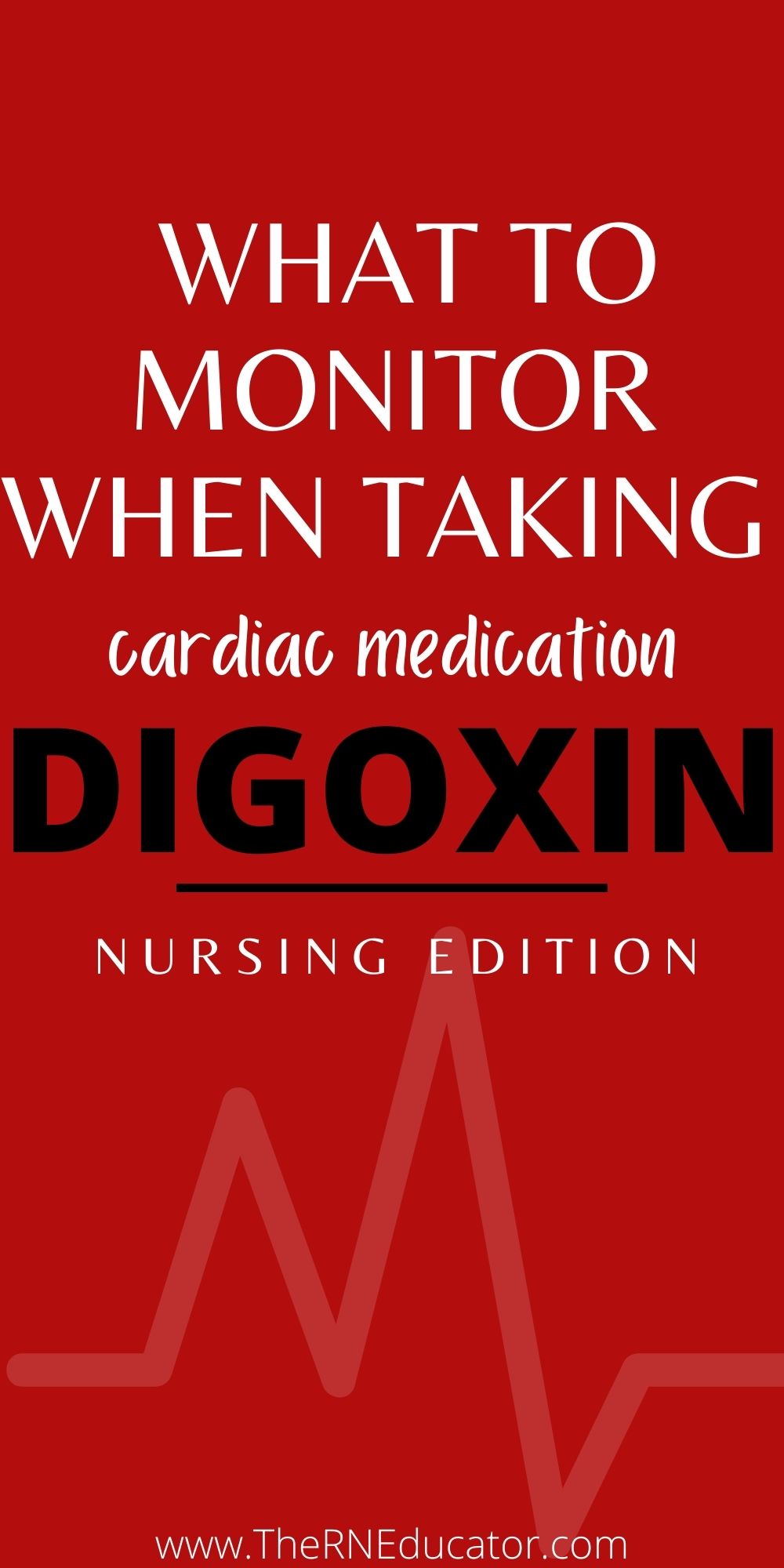What to Monitor When Your Patient Is Taking Digoxin

Hello friends. You know what day it is… Happy Medication Monday! Today we are discussing Digoxin and what to monitor when your patient is taking digoxin, a known and widely used cardiac medication. I know some of you have been wanting to hear more about cardiac and cardiac medications specifically since this system tends to be one of the more difficult subjects in nursing (totally agree, btw!) so let’s jump right into it.

What is Digoxin?
Digoxin, classified as an anti-arrhythmic, is used to control blood pressure and arrhythmias. You may also hear it referred to as a digitalis preparation (which means it is a medication used to treat heart failure). In congestive heart failure, Digoxin is usually the preferred drug in pediatric patients due to its rapid action and shorter half life. Digoxin’s purpose is to slow and strengthen myocardial contraction (in other words, strengthens the heart beat). Think about this — in heart failure, your heart is having problems pumping out blood, it is weak and usually there are certain problems that interfere with your hearts ability to effectively pump and supply enough blood to the rest of your body. In children, these problems are usually congenital but in adults, they can be caused by a number of other things. Digoxin will help improve your cardiac output by improving the hearts ability to pump. It does this by strengthening the contractility of your heart muscle while slowing down your heart rate, reducing strain on the heart.
Dosage forms
Digoxin comes in two forms:
- PO
- IV — Slow IV push is critical, over 5 to 10 minutes. An IV administration that is not pushed slowly can cause serious adverse effects including arrhythmias, which is something you want to monitor when your patient is taking digoxin. IV is usually started in the hospital setting and later transitioned to PO.
- IM — If IM Digoxin is given in older children make sure you give in a large muscle, as this form can be painful and cause tissue damage.
Contraindications
These contraindications are key in what to monitor when your patient is taking digoxin. If there is anything you take away from Digoxin please let it be that you hold the medication if apical heart rate is below these numbers.
- HOLD if resting apical pulse of infant is <90bpm
- HOLD if resting apical pulse of older child is <70bpm
- HOLD if resting pulse for adult is <60bpm
This is critical due to the ability of Digoxin to lower the HR. Pediatric pulse rates vary with each child and because of this you must always ensure the following:
- Take apical pulse for 1 full minute before administering — Use a stethoscope to properly obtain the heart rate especially since infants tend to cry or move around a lot.
- Ensure you have a specific physician order on when to hold digoxin (at what heart rate) but use the above guidelines as a rule of thumb.
- If you hold Digoxin, always notify the physician.
What is Digitalis Toxicity?
Digitalis toxicity is a very serious adverse effect of digoxin intake. It can occur when there are high levels of digoxin circulating the blood or after long-term therapy. This can be caused by too much medication, high doses, or lower tolerance to the drug. Checking serum levels during digoxin therapy is such an important step in what to monitor when your patient is taking digoxin. Note: * Serum digoxin concentration can be within therapeutic range and digitalis toxicity can still occur* It is very important to always assess your patient for the following digitalis toxicity symptoms, hold medication if noted and report to physician immediately.
- Nausea, vomiting, fatigue
- Irregularities in heart rate and rhythm
- Decreased BP, pallor
- Neurological changes – confusion, lethargic, visual disturbances, seizures
- Anorexia, diarrhea
What can put your patient at risk for Digitalis Toxicity:
- Review medication compatibility when administering Digoxin — including complimentary alternative medicines (CAM) as they can have severe interactions with digoxin.
- Dehydration
- Hypokalemia, hypomagnesium, hypercalcemia — These are electrolytes to pay attention to
- Renal conditions — due to the kidneys not being able to eliminate waste + medications
These are important risk factors to look at when identifying what to monitor when your patient is taking digoxin.
Patient Education
Always make sure to educate your patients and their caretaker. In nursing, it is so important to focus on EDUCATION. Without education, it is very likely your patient can get worse or be non-compliant with care. Take the extra time to teach parents how to properly check an apical pulse, when to withhold medication and s/s of digitalis toxicity.
Hope you guys enjoyed this lesson. I’ve included some NCLEX Practice Questions to help recap on what to monitor when your patient is taking digoxin. Challenge yourself and comment below your answers. Also, feel free to share any experiences you’ve had with digoxin and what symptoms did your patient experience? Keep in mind, HIPPA!
Disclaimer: This post is not intended to be used as medical advice and is only intended for educational purposes.
NCLEX Practice Question 1:
Your patient, who is 7 years old is due to take her Digoxin dose. What patient finding would prompt you to hold the upcoming Digoxin dose and notify the physician immediately?
A. Digoxin level of 1.2 ng/ml
B. Potassium level of 2.8mEq/L
C. Heart rate of 74bpm
D. Blood glucose level of 82
NCLEX Practice Question 2:
An infant is being discharged home on Digoxin. Which statement below, verbalized by the infant’s mother, demonstrates proper understanding of patient education? Select all that apply*
A. “I will limit my baby’s intake of foods high in potassium.”
B. “I will not give my baby this medication and notify the physician if his heart rate is less than 90 bpm.”
C. “I will measure my baby’s pulse rate before every dose I take.”
D. “It is important that I immediately report any neurological or GI changes he may experience while taking this medication.”
NCLEX Practice Question 3:
An infant is ordered a scheduled dose of Digoxin. The patient’s apical pulse rate is 78 bpm. The nurse would:
A. Administer the dose as ordered
B. Hold the dose and reassess the apical pulse rate in 1 hour
C. Skip this dose but administer the next scheduled dose
D. Hold the dose and notify the physician
NCLEX Questions Source: RegisteredNurseRN.com
Post your answers below! Will be posting answers in comments section.
’till next time,
The RN Educator

Share this:
Related Posts
What’s in a Pediatric Crash Cart? Nursing Students read NOW!
A pediatric crash cart is a mobile unit containing essential equipment and medications required for…
Share this:
How to Become a Confident Nurse
If you are anything like me, and let’s face it (like every nurse…




therneducator | 14th Sep 20
NCLEX Practice Answer 1:
Your patient, who is 7 years old is due to take her Digoxin dose. What patient finding would prompt you to hold the upcoming Digoxin dose and notify the physician immediately?
B. Potassium level of 2.8mEq/L
NCLEX Practice Answer 2:
An infant is being discharged home on Digoxin. Which statement below, verbalized by the infant’s mother, demonstrates proper understanding of patient education? Select all that apply*
B. “I will not give my baby this medication and notify the physician if his heart rate is less than 90 bpm.”
C. “I will measure my baby’s pulse rate before every dose I take.”
D. “It is important that I immediately report any neurological or GI changes he may experience while taking this medication.”
NCLEX Practice Answer 3:
An infant is ordered a scheduled dose of Digoxin. The patient’s apical pulse rate is 78 bpm. The nurse would:
D. Hold the dose and notify the physician